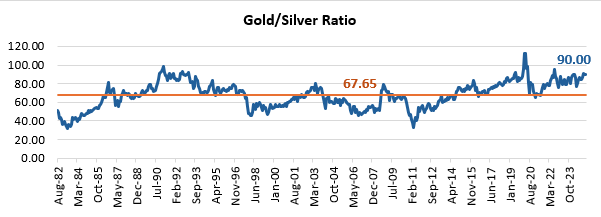Our previous blog Precious Rebound highlighted how, historically, both Gold and Silver have acted as reliable hedges against inflation—with Gold often taking the lead.
However, recent market dynamics suggest that Silver is quietly turning the tables. Today, we delve exclusively into the Gold-Silver ratio, a critical metric that gauges the relative value between these two precious metals.
Highlights
The gold-silver ratio, simply put, is the number of units of silver that can be bought with one unit of gold. Currently the ratio is at 90.
- This ratio almost always converges to its long-term average of 67.5.
- In almost 50% of the cases (since 1980s) where the ratio is above average, the convergence happened with Silver outperforming Gold.
- Additionally, the outperformance of Silver over Gold on average under such instances is nearly 11%.
- If we consider the instances where ratio is above 90, the outperformance is significantly higher at ~27% on average.

Market Implications & Investment Opportunities
Now that the Gold-Silver ratio is again at 90, the market may be signaling that Silver is at a deep value and may outperform gold significantly to reach convergence.
External Factors Enhancing Silver’s Appeal
Amid geopolitical and economic uncertainties, investors are turning to safe-haven currencies. Meanwhile, a supply deficit for the 5th consecutive year and 3% industrial demand growth in 2025 may bolster Silver’s appeal.
Source: Silver Institute
Conclusion
For portfolio diversification, Gold can offer stability, while Silver’s upside potential may justify a larger allocation—making now a key time to reassess precious metals holdings.
Please note that the above should not be construed as an advice from us. Our company is in the business of distribution of suitable Financial Products to investors describing product specifications, material facts and the associated risk factors. We are acting as a Distributor for these products and facilitating transactions.
Subscribe on LinkedIn